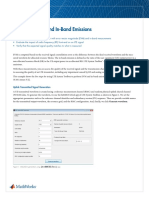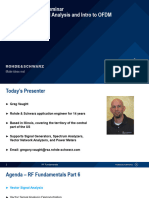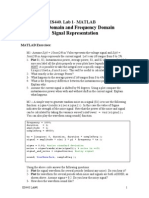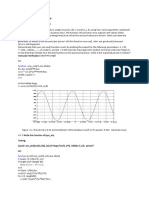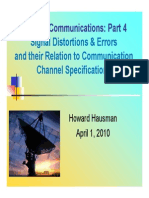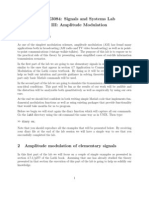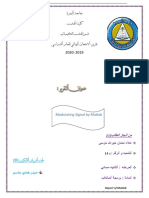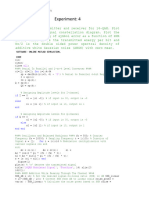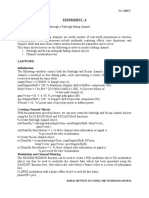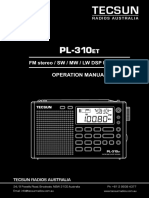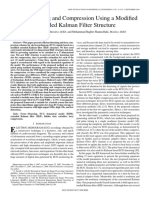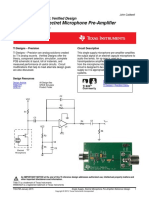12/23/21, 12:29 PM Visualize RF Impairments - MATLAB & Simulink - MathWorks India
Visualize RF Impairments
Apply various RF impairments to a QAM signal. Observe the effects by using
Try This Example
constellation diagrams, time-varying error vector magnitude (EVM) plots, and
spectrum plots. Estimate the equivalent signal-to-noise ratio (SNR).
Copy Command
Initialization
Set the sample rate, modulation order, and SNR. Calculate the reference constellation points.
fs = 1000;
M = 16;
snrdB = 30;
refConst = qammod(0:M-1,M,'UnitAveragePower',true);
Create constellation diagram and time scope objects to visualize the impairment effects.
constDiagram = comm.ConstellationDiagram('ReferenceConstellation',refConst);
timeScope = timescope('YLimits',[0 40],'SampleRate',fs,'TimeSpanSource','property','TimeSpan',1, ...
'ShowGrid',true,'YLabel','EVM (%)');
White Noise
Generate a 16-QAM signal, and pass it through an AWGN channel. Plot its constellation.
data = randi([0 M-1],1000,1);
modSig = qammod(data,M,'UnitAveragePower',true);
noisySig = awgn(modSig,snrdB);
constDiagram(noisySig)
https://in.mathworks.com/help/comm/ug/visualize-rf-impairments.html 1/15
�12/23/21, 12:29 PM Visualize RF Impairments - MATLAB & Simulink - MathWorks India
Estimate the EVM of the noisy signal from the reference constellation points.
evm = comm.EVM('ReferenceSignalSource','Estimated from reference constellation', ...
'ReferenceConstellation',refConst, ...
'Normalization','Average constellation power');
rmsEVM = evm(noisySig)
rmsEVM = 3.1768
The modulation error rate (MER) closely corresponds to the SNR. Create an MER object, and estimate the SNR.
mer = comm.MER('ReferenceSignalSource','Estimated from reference constellation', ...
'ReferenceConstellation',refConst);
snrEst = mer(noisySig)
snrEst = 30.1071
The estimate is quite close to the specified SNR of 30 dB.
Amplifier Distortion
Create an amplifier using the memoryless nonlinearity object.
amp = comm.MemorylessNonlinearity('IIP3',38,'AMPMConversion',0);
Pass the modulated signal through the nonlinear amplifier and plot its constellation diagram.
txSig = amp(modSig);
constDiagram(txSig)
https://in.mathworks.com/help/comm/ug/visualize-rf-impairments.html 2/15
�12/23/21, 12:29 PM Visualize RF Impairments - MATLAB & Simulink - MathWorks India
The corner points of the constellation have moved toward the origin due to amplifier gain compression.
Introduce a small AM/PM conversion, and display the received signal constellation.
amp.AMPMConversion = 1;
txSig = amp(modSig);
constDiagram(txSig)
https://in.mathworks.com/help/comm/ug/visualize-rf-impairments.html 3/15
�12/23/21, 12:29 PM Visualize RF Impairments - MATLAB & Simulink - MathWorks India
The constellation has rotated due to the AM/PM conversion. To compute the time-varying EVM, release the EVM object and
set the AveragingDimensions property to 2. To estimate the EVM against an input signal, omit the
ReferenceSignalSource property definition. This method produces more accurate results.
evm = comm.EVM('AveragingDimensions',2);
evmTime = evm(modSig,txSig);
Plot the time-varying EVM of the distorted signal.
timeScope(evmTime)
https://in.mathworks.com/help/comm/ug/visualize-rf-impairments.html 4/15
�12/23/21, 12:29 PM Visualize RF Impairments - MATLAB & Simulink - MathWorks India
Compute the RMS EVM.
evmRMS = sqrt(mean(evmTime.^2))
evmRMS = 35.5919
Compute the MER.
mer = comm.MER;
snrEst = mer(modSig,txSig)
snrEst = 8.1392
The SNR (≈8 dB) is reduced from its initial value (∞) due to amplifier distortion.
Specify input power levels ranging from 0 to 40 dBm. Convert those levels to their linear equivalent in W. Initialize the output
power vector.
powerIn = 0:40;
pin = 10.^((powerIn-30)/10);
powerOut = zeros(length(powerIn),1);
Measure the amplifier output power for the range of input power levels.
for k = 1:length(powerIn)
data = randi([0 15],1000,1);
txSig = qammod(data,16,'UnitAveragePower',true)*sqrt(pin(k));
ampSig = amp(txSig);
powerOut(k) = 10*log10(var(ampSig))+30;
end
Plot the power output versus power input curve.
figure
plot(powerIn,powerOut,powerIn,powerIn,'--')
legend('Amplifier Output','Ideal Output','location','se')
xlabel('Power In (dBm)')
ylabel('Power Out (dBm)')
grid
https://in.mathworks.com/help/comm/ug/visualize-rf-impairments.html 5/15
�12/23/21, 12:29 PM Visualize RF Impairments - MATLAB & Simulink - MathWorks India
The output power levels off at 30 dBm. The amplifier exhibits nonlinear behavior for input power levels greater than 25 dBm.
I/Q Imbalance
Apply an amplitude and phase imbalance to the modulated signal using the iqimbal function.
ampImb = 3;
phImb = 10;
rxSig = iqimbal(modSig,ampImb,phImb);
Plot the received constellation.
constDiagram(rxSig)
https://in.mathworks.com/help/comm/ug/visualize-rf-impairments.html 6/15
�12/23/21, 12:29 PM Visualize RF Impairments - MATLAB & Simulink - MathWorks India
The magnitude and phase of the constellation has changed as a result of the I/Q imbalance.
Calculate and plot the time-varying EVM.
evmTime = evm(modSig,rxSig);
timeScope(evmTime)
https://in.mathworks.com/help/comm/ug/visualize-rf-impairments.html 7/15
�12/23/21, 12:29 PM Visualize RF Impairments - MATLAB & Simulink - MathWorks India
The EVM exhibits a behavior that is similar to that experienced with a nonlinear amplifier though the variance is smaller.
Create a 100 Hz sine wave having a 1000 Hz sample rate.
sinewave = dsp.SineWave('Frequency',100,'SampleRate',1000, ...
'SamplesPerFrame',1e4,'ComplexOutput',true);
x = sinewave();
Apply the same 3 dB and 10 degree I/Q imbalance.
ampImb = 3;
phImb = 10;
y = iqimbal(x,ampImb,phImb);
Plot the spectrum of the imbalanced signal.
spectrum = dsp.SpectrumAnalyzer('SampleRate',1000,'PowerUnits','dBW');
spectrum(y)
https://in.mathworks.com/help/comm/ug/visualize-rf-impairments.html 8/15
�12/23/21, 12:29 PM Visualize RF Impairments - MATLAB & Simulink - MathWorks India
The I/Q imbalance introduces a second tone at -100 Hz, which is the inverse of the input tone.
Phase Noise
Apply phase noise to the transmitted signal. Plot the resulting constellation diagram.
pnoise = comm.PhaseNoise('Level',-50,'FrequencyOffset',20,'SampleRate',fs);
pnoiseSig = pnoise(modSig);
constDiagram(pnoiseSig)
https://in.mathworks.com/help/comm/ug/visualize-rf-impairments.html 9/15
�12/23/21, 12:29 PM Visualize RF Impairments - MATLAB & Simulink - MathWorks India
The phase noise introduces a rotational jitter.
Compute and plot the EVM of the received signal.
evmTime = evm(modSig,pnoiseSig);
timeScope(evmTime)
https://in.mathworks.com/help/comm/ug/visualize-rf-impairments.html 10/15
�12/23/21, 12:29 PM Visualize RF Impairments - MATLAB & Simulink - MathWorks India
Determine the RMS EVM.
evmRMS = sqrt(mean(evmTime.^2))
evmRMS = 6.1989
Filter Effects
Specify the samples per symbol parameter. Create a pair of raised cosine matched filters.
sps = 4;
txfilter = comm.RaisedCosineTransmitFilter('RolloffFactor',0.2,'FilterSpanInSymbols',8, ...
'OutputSamplesPerSymbol',sps,'Gain',sqrt(sps));
rxfilter = comm.RaisedCosineReceiveFilter('RolloffFactor',0.2,'FilterSpanInSymbols',8, ...
'InputSamplesPerSymbol',sps,'Gain',1/sqrt(sps), ...
'DecimationFactor',sps);
Determine the delay through the matched filters.
fltDelay = 0.5*(txfilter.FilterSpanInSymbols + rxfilter.FilterSpanInSymbols);
Pass the modulated signal through the matched filters.
filtSig = txfilter(modSig);
rxSig = rxfilter(filtSig);
To account for the delay through the filters, discard the first fltDelay samples.
rxSig = rxSig(fltDelay+1:end);
To accommodate the change in the number of received signal samples, create new constellation diagram and time scope
objects.
constDiagram = comm.ConstellationDiagram('ReferenceConstellation',refConst);
timeScope = timescope('YLimits',[0 40],'SampleRate',fs,'TimeSpanSource','property','TimeSpan',1, ...
'ShowGrid',true,'YLabel','EVM (%)');
https://in.mathworks.com/help/comm/ug/visualize-rf-impairments.html 11/15
�12/23/21, 12:29 PM Visualize RF Impairments - MATLAB & Simulink - MathWorks India
Estimate EVM. Plot the received signal constellation diagram and the time-varying EVM.
evm = comm.EVM('ReferenceSignalSource','Estimated from reference constellation', ...
'ReferenceConstellation',refConst, ...
'Normalization','Average constellation power','AveragingDimensions',2);
evmTime = evm(rxSig);
constDiagram(rxSig)
timeScope(evmTime)
https://in.mathworks.com/help/comm/ug/visualize-rf-impairments.html 12/15
�12/23/21, 12:29 PM Visualize RF Impairments - MATLAB & Simulink - MathWorks India
Determine the RMS EVM.
evmRMS = sqrt(mean(evmTime.^2))
evmRMS = 2.7199
Determine the equivalent SNR.
mer = comm.MER;
snrEst = mer(modSig(1:end-fltDelay),rxSig)
snrEst = 31.4603
Combined Effects
Combine the effects of the filters, nonlinear amplifier, AWGN, and phase noise. Display the constellation and EVM diagrams.
Create EVM, time scope and constellation diagram objects.
evm = comm.EVM('ReferenceSignalSource','Estimated from reference constellation', ...
'ReferenceConstellation',refConst, ...
'Normalization','Average constellation power','AveragingDimensions',2);
timeScope = timescope('YLimits',[0 40],'SampleRate',fs,'TimeSpanSource','property','TimeSpan',1, ...
'ShowGrid',true,'YLabel','EVM (%)');
constDiagram = comm.ConstellationDiagram('ReferenceConstellation',refConst);
Specify the nonlinear amplifier and phase noise objects.
amp = comm.MemorylessNonlinearity('IIP3',45,'AMPMConversion',0);
pnoise = comm.PhaseNoise('Level',-55,'FrequencyOffset',20,'SampleRate',fs);
Filter and then amplify the modulated signal.
txfiltOut = txfilter(modSig);
txSig = amp(txfiltOut);
Add phase noise. Pass the impaired signal through the AWGN channel. Plot the constellation diagram.
rxSig = awgn(txSig,snrdB);
https://in.mathworks.com/help/comm/ug/visualize-rf-impairments.html 13/15
�12/23/21, 12:29 PM Visualize RF Impairments - MATLAB & Simulink - MathWorks India
iqImbalSig = iqimbal(rxSig,ampImb,phImb);
pnoiseSig = pnoise(iqImbalSig);
rxfiltOut = rxfilter(pnoiseSig);
constDiagram(rxfiltOut)
Calculate the time-varying EVM. Plot the result.
evmTime = evm(rxfiltOut);
timeScope(evmTime)
https://in.mathworks.com/help/comm/ug/visualize-rf-impairments.html 14/15
�12/23/21, 12:29 PM Visualize RF Impairments - MATLAB & Simulink - MathWorks India
Determine the RMS EVM.
evmRMS = sqrt(mean(evmTime.^2))
evmRMS = 19.4992
Estimate the SNR.
mer = comm.MER('ReferenceSignalSource','Estimated from reference constellation', ...
'ReferenceConstellation',refConst);
snrEst = mer(rxfiltOut)
snrEst = 14.1996
This value is approximately 6 dB worse than the specified value of 30 dB, which means that the effects of the other
impairments are significant and will degrade the bit error rate performance.
See Also
Fading Channels | Impact of RF Effects on Communication System Performance
https://in.mathworks.com/help/comm/ug/visualize-rf-impairments.html 15/15

